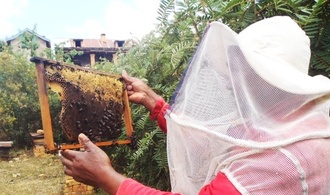Genetics and distribution of varroa in Madagascar
Written by Modified on the
Since it first appeared in 2010, varroa has become a major problem for beekeepers in Madagascar.
A single genetic lineage has already been identified
The Varroa mite jeopardizes the survival of both wild and domestic honeybees and is an indirect threat to Madagascar’s natural and cultivated ecosystems. A. mellifera unicolor, the island’s main species of honeybee, plays an essential ecological role by pollinating roughly 80% of native and cultivated plant species. Three years after first being reported in Madagascar, a study has been carried out to look into the current distribution of varroa across the island and the damage it has it caused to bee colonies. The study,* organizedby the CIRAD, has revealed that the genetic make-up of Madagascan Varroa destructor is very similar to the world’s most common Varroa species and also closely resembles the species frequently found in East Africa known as the "Korean" haplotype.
A limited distribution of varroa across the island
The study shows that due to its relatively slow dispersal speed of 40km/year (compared tospeeds observed in other African countries), the varroa present in Madagascar is so far confined to a handful of regions : the north-east around the island’s main seaport, Tamatave, and in some highland districts around the capital Antananarivo. The presence of the mite in these two regions 400 km apart could be due to separate introductions or a single infestation subsequently spread by an exchange of colonies between the east coast and the capital. The study also suggests that the mite has been introduced several times from different origins, by air and / or sea.
60% of infected colonies lost
Research in the Hauts Plateaux regions has enabled scientist to estimate that 60% of colonies infested with varroa mites are eventually lost. Even though this figure is lower than in Europe, where more than 70% of colonies fail after being infested, such losses will nevertheless have serious economic consequences, particularly for small-scale Malagasy beekeepers. In addition, morphological abnormalities such as deformed wings were detected in bees infested with varroa mites. This defect is may be due to infection with the deformedwing virus (DWV), whose prevalence is probably amplified by the presence of varroa mites.
To protect the remaining varroa-free districts, a management program has been put into operation to prevent the spread of mites via through transport of colonies or exchange of contaminated beekeeping equipment. Another measure which will help contain and control the invasion is an awareness program whose aim is to encourage beekeepers to systematically report infested apiaries to the local authorities. A forthcoming study on the life cycle of honeybee A. mellifera unicolor and its hygiene behaviour will provide a better understanding of the dynamics of Varroa and its likely dispersal across Madagascar.
* Work done by Henriette Rasolofoarivao (financed by CIRAD-AIRD sud) with the University of Antananarivo and the University of La Reunion. Authors : Rasolofoarivao Henriette Johanna Clémencet, Lala Harivelo Raveloson Ravaomanarivo, Dimby Razafindrazaka, Bernard Reynaud, Hélène Delatte.
• Complete article to appear in the next issue of "La Santé de l’Abeille", the bimonthly magazine of the Fédération Nationale des Organisations Sanitaires ApicolesDépartementales (FNOSAD).


